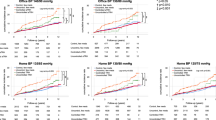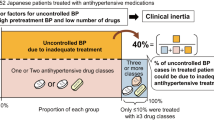Abstract
The prognosis of refractory hypertension is largely unknown due to its low prevalence. This study aimed to investigate the prognosis of refractory hypertension and compare it with those of resistant and nonresistant hypertension. We retrospectively analyzed the data of 16,284 participants with hypertension who underwent ambulatory blood pressure (BP) monitoring between 2012 and 2019 at a tertiary center. Uncontrolled BP was defined as a 24-h BP ≥ 130/80 mmHg as assessed by ambulatory BP monitoring. Resistant hypertension was defined as uncontrolled BP despite the use of three antihypertensive medications, including a diuretic or the use of ≥4 drugs regardless of BP control. Refractory hypertension was defined as uncontrolled BP despite the use of ≥5 antihypertensive medications. Among 16,284 patients with hypertension (mean age 59.2 ± 15.5 years, 52.7% men), 1501 (9.2%) and 150 (0.9%) patients had resistant and refractory hypertension, respectively. The prevalence of chronic kidney disease, end-stage renal disease, heart failure, previous stroke, left ventricular hypertrophy, and the riser/nondipper patterns of circadian BP rhythm progressively increased from patients with nonresistant hypertension to patients with resistant hypertension to patients with refractory hypertension. During a median follow-up of 3.9 years, the risk of cardiovascular mortality progressively increased from patients with nonresistant hypertension to patients with resistant hypertension (hazard ratio 1.62, 95% confidence interval 1.16–2.26) to patients with refractory hypertension (hazard ratio 5.22, 95% confidence interval 3.04–8.96). In conclusion, refractory hypertension, defined as uncontrolled ambulatory BP levels, was associated with a higher risk of all-cause and cardiovascular mortality than nonresistant or resistant hypertension.
This is a preview of subscription content, access via your institution
Access options
Subscribe to this journal
Receive 12 print issues and online access
$259.00 per year
only $21.58 per issue
Buy this article
- Purchase on Springer Link
- Instant access to full article PDF
Prices may be subject to local taxes which are calculated during checkout


Similar content being viewed by others
References
Rapsomaniki E, Timmis A, George J, Pujades-Rodriguez M, Shah AD, Denaxas S, et al. Blood pressure and incidence of twelve cardiovascular diseases: lifetime risks, healthy life-years lost, and age-specific associations in 1.25 million people. Lancet. 2014;383:1899–911.
Ettehad D, Emdin CA, Kiran A, Anderson SG, Callender T, Emberson J, et al. Blood pressure lowering for prevention of cardiovascular disease and death: a systematic review and meta-analysis. Lancet. 2016;387:957–67.
Carey RM, Calhoun DA, Bakris GL, Brook RD, Daugherty SL, Dennison-Himmelfarb CR. American Heart Association Professional/Public E, Publications Committee of the Council on H, Council on C, Stroke N, Council on Clinical C, Council on G, Precision M, Council on Peripheral Vascular D, Council on Quality of C, Outcomes R, Stroke et al. Resistant Hypertension: Detection, Evaluation, and Management: A Scientific Statement From the American Heart Association. Hypertension. 2018;72:e53–e90.
Persell SD. Prevalence of resistant hypertension in the United States, 2003-2008. Hypertension. 2011;57:1076–80.
de la Sierra A, Segura J, Banegas JR, Gorostidi M, de la Cruz JJ, Armario P, et al. Clinical features of 8295 patients with resistant hypertension classified on the basis of ambulatory blood pressure monitoring. Hypertension. 2011;57:898–902.
Carey RM, Sakhuja S, Calhoun DA, Whelton PK, Muntner P. Prevalence of Apparent Treatment-Resistant Hypertension in the United States. Hypertension. 2019;73:424–31.
Sim JJ, Bhandari SK, Shi J, Reynolds K, Calhoun DA, Kalantar-Zadeh K, et al. Comparative risk of renal, cardiovascular, and mortality outcomes in controlled, uncontrolled resistant, and nonresistant hypertension. Kidney Int. 2015;88:622–32.
Daugherty SL, Powers JD, Magid DJ, Tavel HM, Masoudi FA, Margolis KL, et al. Incidence and prognosis of resistant hypertension in hypertensive patients. Circulation. 2012;125:1635–42.
Buhnerkempe MG, Botchway A, Prakash V, Al-Akchar M, Nolasco Morales CE, Calhoun DA, et al. Prevalence of refractory hypertension in the United States from 1999 to 2014. J Hypertens. 2019;37:1797–804.
Acelajado MC, Hughes ZH, Oparil S, Calhoun DA. Treatment of resistant and refractory hypertension. Circ Res. 2019;124:1061–70.
Dudenbostel T, Siddiqui M, Oparil S, Calhoun DA. Refractory hypertension: a novel phenotype of antihypertensive treatment failure. Hypertension. 2016;67:1085–92.
Dudenbostel T, Acelajado MC, Pisoni R, Li P, Oparil S, Calhoun DA. Refractory hypertension: evidence of heightened sympathetic activity as a cause of antihypertensive treatment failure. Hypertension. 2015;66:126–33.
Armario P, Calhoun DA, Oliveras A, Blanch P, Vinyoles E, Banegas JR, et al. Prevalence and clinical characteristics of refractory hypertension. J Am Heart Assoc. 2017;6:e007365.
Calhoun DA, Boothlll JN, Oparil S, Irvin MR, Shimbo D, Lackland DT, et al. Refractory hypertension: determination of prevalence, risk factors, and comorbidities in a large, population-based cohort. Hypertension. 2014;63:451–8.
Lee CJ, Ha JH, Kim JY, Kim IC, Ryu SK, Rhee MY, et al. Office blood pressure threshold of 130/80 mmHg better predicts uncontrolled out-of-office blood pressure in apparent treatment-resistant hypertension. J Clin Hypertens. 2021;23:595–605.
Jhee JH, Seo J, Lee CJ, Park JT, Han SH, Kang SW, et al. Ambulatory blood pressure variability and risk of cardiovascular events, all-cause mortality, and progression of kidney disease. J Hypertens. 2020;38:1712–21.
O’Brien E, Asmar R, Beilin L, Imai Y, Mallion JM, Mancia G.European Society of Hypertension Working Group on Blood Pressure M. et al. European Society of Hypertension recommendations for conventional, ambulatory and home blood pressure measurement. J Hypertens. 2003;21:821–48.
Kim HC, Ihm SH, Kim GH, Kim JH, Kim KI, Lee HY, et al. Korean Society of Hypertension guidelines for the management of hypertension: part I-epidemiology of hypertension. Clin Hypertens. 2019;25:16. 2018
O’Brien E, Parati G, Stergiou G, Asmar R, Beilin L, Bilo G.European Society of Hypertension Working Group on Blood Pressure M. et al. European Society of Hypertension position paper on ambulatory blood pressure monitoring. J Hypertens. 2013;31:1731–68.
Parati G, Stergiou G, O’Brien E, Asmar R, Beilin L, Bilo G.European Society of Hypertension Working Group on Blood Pressure M, Cardiovascular V. et al. European Society of Hypertension practice guidelines for ambulatory blood pressure monitoring. J Hypertens. 2014;32:1359–66.
Levey AS, Stevens LA, Schmid CH, Zhang Y, Castro AF III, Feldman HI, et al. A new equation to estimate glomerular filtration rate. Ann Intern Med. 2009;150:604–12.
Lang RM, Badano LP, Mor-Avi V, Afilalo J, Armstrong A, Ernande L, et al. Recommendations for cardiac chamber quantification by echocardiography in adults: an update from the American Society of Echocardiography and the European Association of Cardiovascular Imaging. Eur Heart J-Cardiovascular Imaging. 2015;16:233–71.
Baek J, Lee H, Lee HH, Heo JE, Cho SMJ, Kim HC. Thirty-six Year Trends in Mortality from Diseases of Circulatory System in Korea. Korean Circ J. 2021;51:320–32.
Lee E, Choi EK, Han KD, Lee H, Choe WS, Lee SR, et al. Mortality and causes of death in patients with atrial fibrillation: a nationwide population-based study. PLoS One. 2018;13:e0209687.
Lee CJ, Oh J, Lee SH, Kang SM, Choi D, Kim HC, et al. Efficacy of aspirin and statins in primary prevention of cardiovascular mortality in uncomplicated hypertensive participants: a Korean national cohort study. J Hypertens. 2017;35:S33–S40.
Williams B, Mancia G, Spiering W, Agabiti Rosei E, Azizi M, Burnier M, et al. 2018 ESC/ESH Guidelines for the management of arterial hypertension: The Task Force for the management of arterial hypertension of the European Society of Cardiology (ESC) and the European Society of Hypertension (ESH). Eur Heart J. 2018;39:3021–104.
Cardoso CRL, Salles GF. Refractory Hypertension and Risks of Adverse Cardiovascular Events and Mortality in Patients With Resistant Hypertension: A Prospective Cohort Study. J Am Heart Assoc. 2020;9:e017634.
Salles GF, Cardoso CR, Muxfeldt ES. Prognostic influence of office and ambulatory blood pressures in resistant hypertension. Arch Intern Med. 2008;168:2340–6.
Williams B, MacDonald TM, Morant S, Webb DJ, Sever P, McInnes G. British Hypertension Society’s PSG. et al. Spironolactone versus placebo, bisoprolol, and doxazosin to determine the optimal treatment for drug-resistant hypertension (PATHWAY-2): a randomised, double-blind, crossover trial. Lancet. 2015;386:2059–68.
Acknowledgements
This research was supported by a Research Program (2021-ER0903-00) funded by the Korea Disease Control and Prevention Agency.
Author information
Authors and Affiliations
Corresponding author
Ethics declarations
Conflict of interest
The authors declare no competing interests.
Additional information
Publisher’s note Springer Nature remains neutral with regard to jurisdictional claims in published maps and institutional affiliations.
Supplementary information
Rights and permissions
About this article
Cite this article
Yoon, M., You, S.C., Oh, J. et al. Prevalence and prognosis of refractory hypertension diagnosed using ambulatory blood pressure measurements. Hypertens Res 45, 1353–1362 (2022). https://doi.org/10.1038/s41440-021-00845-5
Received:
Revised:
Accepted:
Published:
Issue Date:
DOI: https://doi.org/10.1038/s41440-021-00845-5
Keywords
This article is cited by
-
2023 update and perspectives
Hypertension Research (2024)
-
Statement on chronotherapy for the treatment of hypertension: consensus document from the Korean society of hypertension
Clinical Hypertension (2023)
-
Resistant hypertension: consensus document from the Korean society of hypertension
Clinical Hypertension (2023)
-
Role of home blood pressure monitoring in resistant hypertension
Clinical Hypertension (2023)



